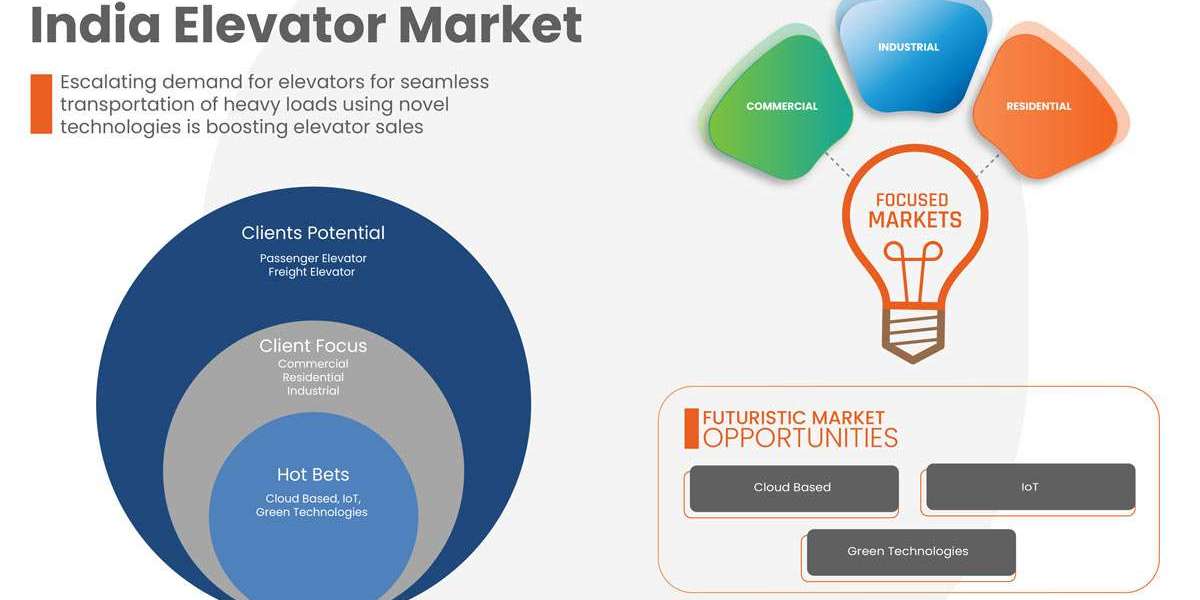Introduction
The India elevator market is undergoing rapid transformation, driven by increasing urbanization, infrastructure development, and the booming real estate sector. Elevators, once considered a luxury in residential and commercial buildings, have now become a necessity across urban India. They play a vital role in ensuring accessibility, optimizing vertical transportation, and improving safety and convenience in modern architecture.
India’s economic expansion, coupled with government initiatives promoting smart cities and affordable housing, has significantly accelerated elevator installations across the country. From high-rise residential projects to large-scale metro stations, hospitals, and malls, the demand for elevators continues to grow steadily. Additionally, advancements in elevator technology such as energy-efficient systems, Internet of Things (IoT) integration, and destination control systems are revolutionizing how buildings manage mobility.
Stay ahead with crucial trends and expert analysis in the latest India Elevator Market report. Download now: https://www.databridgemarketresearch.com/reports/india-elevator-market
Market Overview
The India elevator market has shown impressive growth over the last decade. In 2024, it was valued at approximately USD 2.5 billion and is expected to reach nearly USD 4.5 billion by 2032, registering a CAGR of about 7% during the forecast period. This growth is fueled by rising urban migration, increased construction of high-rise buildings, and the modernization of existing infrastructure.
India is one of the fastest urbanizing nations in the world. With over 35% of its population living in urban areas and this number expected to reach 40% by 2030, the demand for vertical transportation solutions is increasing significantly. The construction of metro systems, airports, smart commercial complexes, and luxury housing projects across cities such as Mumbai, Delhi, Bengaluru, Chennai, and Hyderabad has fueled elevator installations at an unprecedented rate.
Moreover, modernization projects in old residential and government buildings are creating new opportunities for elevator retrofitting and replacement. The increasing adoption of energy-efficient and gearless elevators is helping reduce electricity consumption and operational costs, aligning with India’s sustainability goals.
Key Market Drivers
Rapid Urbanization and Real Estate Growth
India’s expanding urban population is driving the construction of high-rise residential and commercial buildings. As space becomes a constraint in cities, vertical expansion has become essential. This has led to a surge in demand for elevators in both new and existing constructions.Government Infrastructure Initiatives
The Indian government’s “Smart Cities Mission,” “Housing for All,” and metro rail projects have played a crucial role in shaping the elevator industry. These initiatives have encouraged the construction of modern urban infrastructure that requires efficient vertical mobility systems.Technological Advancements in Elevator Systems
The market is witnessing major innovations such as machine-room-less (MRL) elevators, regenerative drives, and IoT-enabled smart elevators. These systems not only enhance performance and safety but also optimize energy efficiency. Predictive maintenance technology allows real-time monitoring, reducing downtime and maintenance costs.Increasing Demand from the Commercial Sector
With the rapid expansion of office spaces, shopping malls, hotels, and hospitals, commercial demand for elevators has surged. Elevators designed with advanced safety systems, smooth operation, and energy-saving features are in high demand.Focus on Sustainability and Energy Efficiency
The growing emphasis on green buildings and energy conservation is boosting the adoption of eco-friendly elevators. Manufacturers are investing in lightweight materials, regenerative braking systems, and intelligent control mechanisms to improve energy efficiency and reduce carbon footprints.
Market Segmentation
The India elevator market can be segmented by type, service, end-user, and region.
By Type
Passenger Elevators: Dominant in the market, primarily used in residential and commercial buildings.
Freight Elevators: Designed for transporting goods in warehouses, factories, and retail centers.
Hospital Elevators: Equipped with specialized safety and hygiene features for medical facilities.
Service Elevators: Common in hotels and restaurants for internal operations.
By Service
New Installation: The largest segment, driven by real estate expansion and infrastructure development.
Maintenance and Repair: Increasing due to aging building structures and safety requirements.
Modernization: Growing steadily as older elevators are upgraded with smart and energy-efficient technologies.
By End-User
Residential Sector: The fastest-growing segment, supported by urban housing projects and luxury apartments.
Commercial Sector: Includes offices, malls, hotels, and airports, with rising demand for high-speed elevators.
Industrial Sector: Used in manufacturing facilities, logistics hubs, and warehouses.
Public Infrastructure: Growing segment driven by government investments in metro stations, hospitals, and airports.
By Region
North India: Strong demand from Delhi NCR and surrounding urban centers.
South India: Major markets include Bengaluru, Chennai, and Hyderabad, known for real estate and IT infrastructure.
West India: Mumbai and Pune remain significant due to their dense urban populations and skyscraper developments.
East India: Gradually growing market led by developments in Kolkata and Bhubaneswar.
Competitive Landscape
The India elevator market is highly competitive and features both domestic and international players. Key companies include KONE India, Otis Elevator Company (India) Ltd., Schindler India, Mitsubishi Electric India, and Thyssenkrupp Elevator India. These companies dominate the market through strong distribution networks, advanced technologies, and customized service offerings.
KONE India focuses on eco-efficient products and digital connectivity. Its smart elevator solutions use real-time data for predictive maintenance and energy optimization.
Otis India is expanding its portfolio with Gen2 elevators featuring machine-room-less systems and regenerative drives.
Schindler India emphasizes safety and smart mobility, offering connected elevators that can be monitored remotely.
Thyssenkrupp Elevator and Mitsubishi Electric continue to invest in advanced vertical and horizontal transportation systems, catering to high-rise buildings and commercial complexes.
Local manufacturers like Johnson Lifts and Eros Elevators are also making significant contributions by offering affordable and customized products for the domestic market. Strategic collaborations, digital service innovations, and after-sales support are key competitive strategies shaping the industry.
Challenges and Restraints
Despite its promising growth, the India elevator market faces several challenges. One of the major concerns is the lack of standardization and safety regulations across smaller cities and semi-urban areas. Inadequate enforcement of maintenance norms sometimes leads to operational risks and safety issues.
Another challenge is high initial installation and maintenance costs, which can discourage small builders or residential societies from adopting advanced elevator systems. Moreover, the shortage of skilled technicians affects the timely servicing and repair of elevators, especially in remote areas.
The industry also faces challenges related to supply chain disruptions and fluctuating raw material prices, impacting manufacturing costs. Additionally, the rising competition among low-cost manufacturers may affect product quality and long-term reliability.
Future Outlook
The future of the India elevator market looks exceptionally promising. As the country continues its rapid urbanization journey, vertical growth in real estate will remain a key driver. The market is expected to witness increased adoption of AI-based predictive maintenance, smart elevator systems, and touchless technology to enhance user experience and safety.
Furthermore, the rise of sustainable construction practices will encourage the use of energy-efficient elevators. The integration of IoT and cloud-based monitoring will allow real-time performance tracking and predictive servicing. Additionally, expanding metro and airport projects, coupled with growing commercial infrastructure, will ensure consistent demand through 2032.
Domestic manufacturing under the “Make in India” initiative will strengthen local supply chains and reduce dependency on imports. Companies focusing on innovation, cost efficiency, and after-sales service will have a competitive edge in this evolving market.
Conclusion
The India elevator market is on a strong growth trajectory, supported by urbanization, technological advancement, and government-led infrastructure development. Elevators have become an essential component of modern urban life, symbolizing both convenience and progress.
With increasing demand for smart, energy-efficient, and sustainable solutions, the industry is entering a new era of innovation and modernization. As India continues to build upward, the elevator market will remain an integral part of its urban transformation journey, offering immense opportunities for both global and domestic players.
Frequently Asked Questions (FAQs)
1. What is the growth rate of the India elevator market?
The India elevator market is projected to grow at a CAGR of approximately 7% between 2024 and 2032.
2. Which regions are driving demand in the India elevator market?
Major demand comes from urban centers such as Mumbai, Delhi, Bengaluru, Chennai, and Hyderabad, supported by rapid urbanization and real estate development.
3. Who are the leading players in the India elevator market?
Key players include KONE India, Otis Elevator Company, Schindler India, Thyssenkrupp Elevator, and Mitsubishi Electric India.
4. What are the major challenges faced by the India elevator market?
Challenges include high installation costs, inconsistent safety standards, shortage of skilled labor, and supply chain disruptions.
5. What are the future opportunities in the India elevator market?
Future opportunities lie in smart elevator technologies, eco-friendly systems, modernization of old infrastructure, and government-led urban development projects.
Browse More Reports:
Global Cold Sore Treatment Market
Global Combat Management System Market
Global Combine Heads and Harvester Market
Global Commercial Security Systems Market
Global Companion Animal Ear Infection Treatment Market
Global Concentrated Photovoltaic (PV) (Concentrated Photovoltaic (Cvp) and High Concentrated Photovoltaic (Hcvp)) Market
Global Confectionery Glazing Agents Market
Global Connected Healthcare Market
Global Construction Fabrics Market
Global Container Security Market
Global Converged Cable Access Platform (CCAP) Market
Global Cooled Mid-Wave Infrared Sensors Market
Global Copper Azoles Market
Global Corneal Surgery Devices Market
Global Corporate Banking Solutions Market
Global Corrugated Box Making Machine Market
Global Crew Boats Market
About Data Bridge Market Research:
An absolute way to forecast what the future holds is to comprehend the trend today!
Data Bridge Market Research set forth itself as an unconventional and neoteric market research and consulting firm with an unparalleled level of resilience and integrated approaches. We are determined to unearth the best market opportunities and foster efficient information for your business to thrive in the market. Data Bridge endeavors to provide appropriate solutions to the complex business challenges and initiates an effortless decision-making process. Data Bridge is an aftermath of sheer wisdom and experience which was formulated and framed in the year 2015 in Pune.
Contact Us:
Data Bridge Market Research
US: +1 614 591 3140
UK: +44 845 154 9652
APAC : +653 1251 975
Email:- corporatesales@databridgemarketresearch.com








